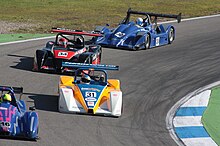Group CN

Group CN is a category of vehicles used in motorsport, introduced by the FIA in 1993 for sports car racing.[citation needed] Group CN cars are mainly used in hillclimbing championships or sports racing series. Group CM is a non-FIA class which is closely related to Group CN.
Major racing series[edit]
Group CN rules are applied to a variety of championships. Many championships alter the rules in their own way like the Radical European Masters and V de V championships.
Radical European Masters[edit]
The Radical European Masters is a spec racing series in Europe. It features the Radical SR8, Radical RXC Spyder and Radical SR3, each in their own class.
V de V[edit]
The French-based V de V organisation features two FFSA Group CN based classes. The endurance championship is open for any chassis and engine within the regulations. The V de V organisation also features the Funyo Challenge open to Peugeot powered Funyo 4 or Funyo 5.
Indian Racing League[edit]
From 2022, the Indian Racing League has used Wolf GB08 "Thunder" models built to Group CN specification.[1]
National championships[edit]
A Group CN racing class exists in many countries, many of which utilize radicals. Examples are the Radical UK Cup which features the Radical SR3 and the Open España Prototipos.
GT & Prototype Challenge[edit]
Ran as part of the Benelux-based Supercar Challenge, the GT & Prototype Challenge allows Group CN classification cars to compete; current competitors include the Radical SR3 and Norma M20 FC.
FIA Group CN technical regulations[edit]
| Engine | Maximum of 8 cylinders and 3000cc, homologated by the FIA in Group N. |
| Drivetrain | Free, with a maximum of 6 forward ratios. Reverse gear is compulsory. |
| Maximum dimensions | Length: 4800mm |
| Width: 2000mm | |
| Height: 1030mm | |
| Front plus rear overhangs not to exceed 80% of the wheelbase. | |
| Difference between front and rear overhangs not to exceed 15% of the wheelbase. | |
| Bodywork | Open or closed cockpit |
| Rear wing | Maximum of 2 elements, which must fit within a 150x400mm cross section. Maximum span of 1800mm |
| Minimum weight (without driver) | Related to engine capacity |
| Up to 1000cc: 475 kg | |
| 1000cc - 1300cc: 495 kg | |
| 1300cc - 1600cc: 515 kg | |
| 1600cc - 2000cc: 535 kg | |
| 2000cc - 2500cc: 575 kg | |
| 2500cc - 3000cc: 625 kg |
See also[edit]
References[edit]
- ^ "Indian Racing League to debut with 5 City Teams from Nov 19th at Hyderabad and Chennai". Wolf Racing Cars. 7 November 2022.
- ^ Technical Regulations for Production Sports Cars (PDF). FIA Sport / Technical Department. 2011. pp. 1–19.


 French
French Deutsch
Deutsch